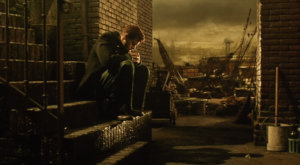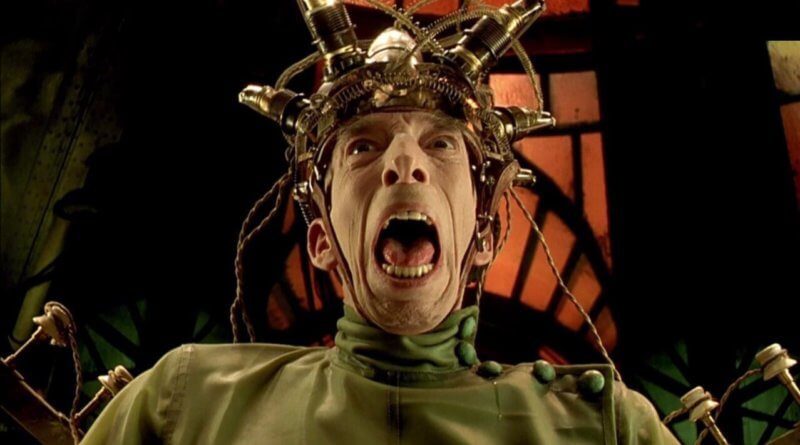Review: The City of Lost Children (1995) ★★½
There is no denying that Terry Gilliam is a brilliant filmmaker, and he is deserving of the veneration and even imitation of his peers. In Jean-Pierre Jeunet and Marc Caro’s 1991 black comedy, Delicatessen, the style and dystopian setting pay homage to Gilliam, but still manages to function well as a unique film all its own. It is funny, dark, disturbing, baffling, and a wonderfully surreal experience to watch. Similarly, its spiritual successor, The City of Lost Children, though it strikes a somewhat lighter tone than its predecessor, still succeeds in being disturbing, baffling, and surreal. The only problem is that, while Delicatessen is a very entertaining film, The City of Lost Children is dreadfully slow, and not nearly as engrossing as it aspires to be.
The City of Lost Children is set in a dystopian city on the water, wherein children live in fear of being exploited for profits or kidnapped by a group of militant cyborgs known as Cyclops. The cyborgs kidnap children and bring them to a mad scientist, Krank (Daniel Emilfork), who resides in a nearby oil rig, along with a functioning brain in a vat, a dwarf named Martha (Mireille Mossé), and six identical clones (all played by Dominique Pinon). Krank brings the children to his laboratory in order to steal their dreams, as he is unable to have his own dreams, which has caused him to age prematurely. One of the kidnapped children, Denree (Joseph Lucien), is the defacto child of local strongman, One (Ron Perlman). Devastated by the loss of his closest friend, One joins up with an orphan named Miette (Judith Vittet) to try to save Denree and the rest of the lost children.
Visually, The City of Lost Children bears a strong resemblance to its predecessor, insofar as the mise en scène is dark, even depressing, but nonetheless highly stylized and fantastic. The sets are perhaps the film’s crowning achievement, creating a gloomy and unforgiving dystopia in which the characters face injustice or indifference at every turn. The characters themselves fit well in the environment, almost like extensions of the crooked streets and harbor that looks like it was pulled straight from a surrealist painting. However, their behavior is clownish to an extreme, and while this was also generally the case in Delicatessen, it felt more natural and justified in that particular narrative. In The City of Lost Children, all of the characters feel like unsavory cartoons.

Though it is aesthetically impressive, the narrative is rather erratic, and not in a fun and whimsical way. One, who serves as the film’s primary source of morality and goodness, does not drive the narrative in any particular direction; parts of the plot are poorly explained and leave the viewer to surmise certain points on their own. In some respects, it is refreshing to have dystopian films that don’t over-explain things, but in such a strange and inexplicable narrative world, a few moments of exposition would have been welcome. This confusion is made worse by the fact that the plot meanders about without any rush to reach its conclusion. It seems as though the filmmakers put so much effort into visual extravagance that they forgot to pace the film in an effective or entertaining way.
Even if one can forgive the poor pacing, filmmakers Jean-Pierre Jeunet and Marc Caro have the uncanny ability to frame their actors in a way that makes them highly unappealing. Perhaps this is just an incidental side effect of the cinematography, but, incidental or not, it gives one a certain queasy feeling that does not work in the film’s favor. Krank is particularly off-putting, his veins bulging as he spits vitriol at his subordinates, but it also holds true for virtually all of the characters. This was particularly disappointing, as I found myself cringing every few minutes, hardly able to look at these bizarre figures bounding through dismal streets and attaching themselves to frightening laboratory equipment. In a film that prides itself on exceptional photography, it is antithetical to make spectators want to look away.
While it is a shame that such a visually unique film disappoints in so many respects, The City of Lost Children is still worth watching, particularly for those interested in surrealist cinema.
Rating: ★★½ out of 5
The City of Lost Children is available to rent or purchase via Amazon here.


This critic doesn’t get this film. Hopefully he has changed careers to work as a tax accountant or toll booth operator. He would do fine as a deck hand on a tanker leaving The City of Lost Children. Not sure why someone would watch films for a living who lacks nuance and understanding of filmmaking. I’ll give this film it’s proper respect of 4 out of 4 stars. This is one of my favorite films ever…one of those great films that is better in a movie theater where I originally enjoyed it upon it’s release. I rarely comment on the Internet, but this guy is so off in his perspective I am compelled to defend the artistic brilliance of this work.
This critic would do fine as a deck hand on a tanker leaving The City of Lost Children forever. Yes the characters are intentionally creepy. Yes the pacing of the film is slowed down intentionally. Yes the narrative thread leaves space for the viewer to interpret. All great elements of this film. It would be lesser without the specific choices made in support of the directors’ vision not better.